Another Controversial Practice
Earlier this month I mentioned that I asked my tarot friends if they had any beliefs or practices that they thought others would think was controversial. One commonly shared statement was that not letting the querent shuffle was outside the normal practice. And I recently shared my fledging idea that maybe the tarot doesn’t always tell us the truth but rather what we need to know, even if it isn’t the truth.
Another allegedly controversial belief was that astrological and Kabbalistic correspondences are not necessary and may, in fact, be overrated in learning and reading the cards.
As usual, I am interested in your thoughts and experiences with these systems. I know that I did study both and then let them go. My reason was that neither felt like a smooth fit but rather forced, so I didn’t see the point in learning two new languages (astrology and Kabbala) in order to learn and effectively read tarot. So they do not play an active role in my readings or my ever-evolving understanding of the cards. I do know that those for whom these systems resonate, they add a lot to their understanding. Why is it true for some and not others? Does it matter? Tell me what you think.








I’ve given both disciplines a fair shake, but I don’t use them. Astrology always seemed too fatalistic and unmalleable, unlike the empowerment that springs forth from the tarot. Kaballa doesn’t speak to my view of the Universe. I think the tarot has grown and blossomed from the ceremonial magick revival it experienced with the RWS deck that these disciplines, while useful for many readers, are not necessary to be a successful and insightful reader.
One of the things that I like to point out is that the Golden Dawn used a completely different deck of Tarot cards than we do. In Golden Dawn, the three of wands just shows three wands being held by an angelic hand–that is it, nothing more. You need the kabbalistic and astrological associations to give it more meaning because otherwise you just have the number three and the suit of wands to guide your reading.
On the other hand, what most of us use (including myself, someone who trained in a Golden Dawn based system) is a variation of/development from the Rider/Waite/Smith deck which has pictures; pictures that can speak directly to the reader and/or client. If there is a card with a turtle on it, and you were once bit by a turtle, it does not matter what the kabbalistic/astrological associations are–it is the turtle that you are going to be cautious about.
Personal associations drawn from the pictures trump the skeletonic framework.
I like what Ty said about a discipline not resonating with my view of the Universe. I frequently find that to be true in relationship to Tarot. It’s important to know what symbolic language speaks to you and use that in relationship with Tarot. I like and resonate with numerology and my rather surface knowledge dovetails with Tarot for the most part.
I have also been approaching Tarot shamanically and teaching myself to blend that discipline I know very well with Tarot. For me, it integrates beautifully.
[…] Another Controversial Practice (llewellyn.com) […]
I think it’s important to focus on disciplines that feel right to you and leave behind those that don’t. Forcing them always becomes a hindrance to me in the end. I also think the blending of your own beliefs, practices, and disciplines offers your readings new perspective that some quearents might need. There’s a reason Kabbalah resonates with some and astrology with others, etc. People are and always will be reached through various avenues; I think it’s good to be aware and accepting of that.